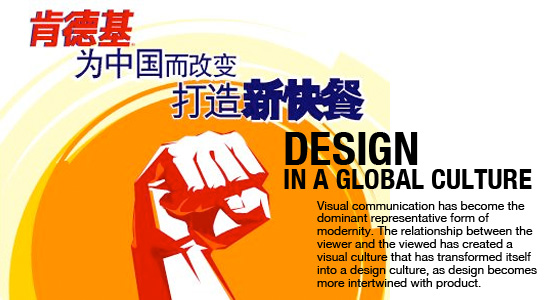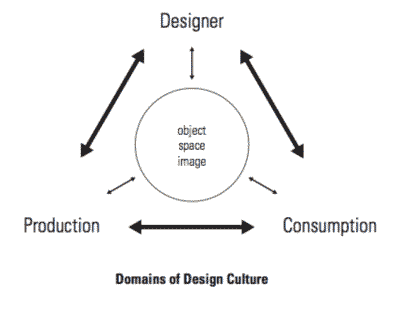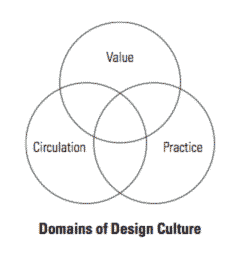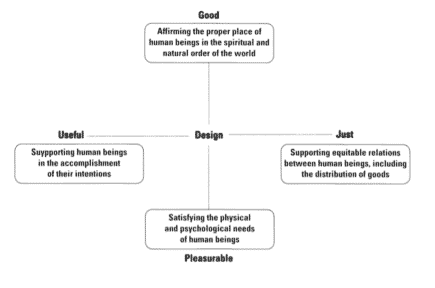Design in a Global Culture

Visual communication has become the dominant representative form of modernity. The relationship between the viewer and the viewed has created a visual culture that has transformed itself into a design culture, as design becomes more intertwined with product. This design culture is also affected by its presence in a global culture (The “Global Village”). Design is being transformed not only by its medium, but also its location. This essay hopes to understand Design cultures positions in different cultures and in contemporary culture.
What is Visual Culture?
According to Nicholas Mirzoeff, “Visual culture is concerned with visual events in which information, meaning or pleasure is sought by the consumer in an interface with visual technology” (Mirzoeff). Here visual technology is defined as any method or form to be looked at, including televisions, drawings, road signs and icons.
Modern society is ‘imaging’ society. DIgital cameras are accessable on almost all modern mobile phones now, and this is affordable and accessable to most people in different cultures. The taking of and distribution of images is now big business. ‘Instagram’, the image sharing platform was recently purchased by Facebook for $1 billion.
The visualization of the world is only a recent concept. The earliest cave paintings in France were secretive, hidden away, in the dark and difficult to get to crevasses. Artists in Ancient Egypt were those who ‘bought back from the dead’. Up until the medieval world, images were not artificial representations and imitations, but iconic. Images of the Byzantine Saints were the saints.
With the rise of the industrial revolution, new visual mediums were invented - film, animation and photography. Images became mass produced and affordable. The old mediums of visual replication (oil painting) had to adapt and redefine itself, looking beyond the image into its construction and its meaning. Impressionism, Fauvism, Post-Impressionism and Cubism were born.
Andy Warhol best defined the modern images meaning in his ‘Factory’ and his wish to be a machine - Mass produced images of the mundane.
Image making has been taken away from artists, designers and professionals, and into the hands of the crowd. Many of the last decades most memorable images have come from amateurs, sometimes anonymous. The death of the Iranian student and Gaddaffi. Tsunamis in Indonesia and Japan.
Visual Culture is a threat to Authoritarian governments wishing to control culture. Youtube started as a video sharing website, now is a social visual record easily distributed. It was one of the first social media websites banned in China (Perhaps ironic that Chen Guangcheng, the recently escaped Chinese dissident feared by the government, is blind). A more extreme example is the Taliban, who have a strictly policed visual culture in which “the everyday practices of human display...are subject to regulation” (Mitchell, 2002, p179)
What is Design Culture?
Design Culture is about formal characteristics of artifacts and how these are formed along with the meanings design attaches to them. Artifacts are created from the design process of product development. It’s also concerned with “...the interrelationships between design artifacts, in all their manifestations, the work of designers, design production (including marketing, advertising and distribution), mediation and their consumption.” (www.designculture.info)
Design Culture can be seen in, and defined in a number of ways:
Design Culture as a process - the most common usage. “The process is understood to be produced within and by a network or everyday knowledge and practices that surround the designer” (Julier, 2006, p70). The process involves all stages of design - brief, concept, prototyping, production, distribution, placement and feedback.
Design culture as context-informed practice. implies “collectively-held norms of practice shared within or across contexts” (Julier, 2006, p70). This usually refers to the way geographic, economic and political factors could influence the practice and results of design.
This can also make Design culture a platorm for communication through forums, allowing dispersed and isolated people and designers to connect and communicate, their activities.
Design culture as organisational or attitudinal. ...an organizational spine within a company that concerns itself with both innovation and formal coherence”...leading to “cultural capital” of a company-its facility to qualify, critique, and thus deliver distinction and differentiation.” (Julier, 2006, p71). Apple would be the largest company with a strong design culture. Google also encourages a design culture, allowing 20% of all work time to be spent on personal projects. One of the most successful of these personal projects is the Google Art Project (www.googleartproject.com).
Design culture as an agency - a way to be appropriated, into attempts to reform the aims, practices, and effects of design toward greater and more direct social and environmental benefit (Julier, 2006, p71). Thinking of design aiming for a higher moral ground, the Kony 2012 campaign against a brutal Ugandan militia group was created with the intention of making Kony into a celebrity through visual communication (and distribution)
Design Culture as pervasive but differentiated value. Can design be “excellent”? Can it be successful? Is the design “good”? What is a design industry? What is the value of design?
“What is described here is a qualitive change in terms of how design is practiced, circulated, and perceived. As with Visual Culture, we are not talking about the replacement of one cognitive process by another. Rather, a shift takes place wherein design takes up a central role, as commonplace, in creating and articulating value, structuring the circulation of information and forming everyday practices...it seems apt to regard design culture as a key result and expression of our times” (Julier, 2006, p71)
The circulation of images and design is now a major industry. “The proliferation of images became a key characteristic of modern social organization” (Mitchell, 2002, p65). Instagram, Facebook, Twitter, Youtube are big businesses and major social influences have a strong focus on image collection and distribution.
Mass media markets have been created, products commodities and services needed to become more ‘self conscious’ to be advertised and marketed to these new mass markets. In 1998 the Australian Tax Office famously hired woman’s magazine editor, Ita Buttrose, to re-design the complicated Australian Tax Forms into a more user friendly, easier to comprehend and less intimidating format.
“Culture is no longer one of pure representation or narrative, where visual culture conveys messages. Instead, culture formulates, formats, channels, circulates, contains, and retrieves information. Design therefore, is more than just the creation of visual artifacts to be used or “read”. It is also about the structuring of systems of encounter within the visual and material world” (Julier, 2006, p 67). These systems create a relationship between the produced object and consuming subject (viewer). Google has become one of the largest and profitable companies in the world by making the viewer also the product. Facebook is similar. Both companies allow viewer/product to share their visuals/products, recording this and repackaging it as advertisements and market research.
The merging of viewer/product also corresponds with the product and sign becoming one. This is commonly known as ‘branding’. Branding has a strong influence on design practice. “The imperative of modern design is to make things visual in order to commodify them” (Julier, 2006, p 68). Major corporations are known more by their logos (and the people who use them), than by name. This also helps in international markets. Artifacts are no longer just made, but designed dominated by “styling, coding, and effective communication with an audience” (Julier, 2006, p68).

Above: Julier’s “Domains of Design Culture” diagram showing the relationship between a design and the elements surround it (Design, Production and consumption) (Julier, 2006, p73)

Above: Julier’s revised Domains of Design Culture showing the intersection of Value, Practice and Circulation (Julier, 2006, p74)
Relationships Influencing Design Culture
Value. The designers role in the creation of value. Not constrained to commercial value, but also including “social, cultural, environmental, political, and symbolic value” (Julier, 2006, p74).Value should not be connected wit the concept of “good design”
Circulation: Circulation: Distribution is only a part of circulation. This includes design technologies, environmental, and human factors. But “non material elements such as existing knowledge networks, legilation, political pressures, economic fluctuations, and fiscal policies are also contextual factors that these draw on” (Julier, 2006, p74)
Practice Things are bought and used and consumed. The use of designed products and processes in everyday society is not just a function of consumer culture in its traditional sense. It involves observable behaviour.
Design in the Global Village
The forces of globalism and globalization are bringing cultures and communities closer together. It is now at a point where, through the influence of mass media, access to communication and the influence of multinational companies. a global culture is rapidly moving towards homogeny. To clarify the difference between the two forces, Globalism is a world “characterized by networks of connections that span multi-continental distances.” Globalization “refers to the increase or decline in the degree of globalism. It focuses on the forces, dynamism or speed of these changes”(Nye 2002). We are now living in what Marshal McLuhan called “The Global Village”, where time, distance and space has vanished. While globalism is destroying diversity through overwhelming, ignoring and overlooking local cultures, the internet has created opportunities to superficially substitute tribal or national communities for virtual ones to which individuals with common interests are linked. Some homogenous cultures are embracing globilisation, thereby becoming heterogeneous, while others are trying to defy it, or are selective. (Shen et all. 2006, p823). China and North Korea are two examples of homogenous cultures facing globalization. China’s embrace of globalization has seen it’s rapid rise to economic superpower, while North Korea, once the economic equal of South Korea, has resisted globalization. This resistance has seen living standards decline, famine, and a government controlling all aspects of life, society and culture.
Within globalisation are different processes of development, adaption and adoption of artifacts:
Internationalisation
The process of creating a base design that can be easily adapted for various international markets (Shen et all. 2006, p823). This is a “cheap and easy” process, that is less flexible than other processes, but are easier to manage, produce and export to different markets with lower costs and maintenance. McDonald’s and Ikea are two companies in China using this process
Localisation
The process of making a specific version of the product for a target market. This involves customizing features, designs and products. Contrary to McDonald’s, KFC in China is customizing its menu to suit local tastes. The menu may be unrecognizable to an Australian menu, but the branding is still the same.
Glocalisation
This occurs when countries cultures adopt elements from other cultures without losing their original identity. “The ability of a culture, when it encounters other strong cultures, to absorb influences that naturally fit into and can enrich that culture, to resist those things that are truly alien and to compartmentalize those things that, while different, can nevertheless be enjoyed and celebrated as different (Friedman, 2000).
Multiculturalism in Australia can be seen as an effective process of cultural adaption, while maintaining identity.
Iconisation
The swapping of verbal for visual. Most major corporate brands have, or are in the process of shedding their names in favour of representation by icons. Nike, Apple, Shell logos have become icons representing their authority.
Culturalisation
This is a reaction to globalisation, though it has occured by globalizations presence. Global homogenization can make people more aware of their national and cultural identities. Vegemite is a (foreign) brand that celebrates its local cultural identity. Beer advertising is strongly local (Queenslanders drink XXXX, Melbournians, VB, Australians, apparently Fosters).
Design in Contemporary in an International Culture
Globalization, combined with design developments and technological improvements have promised much to better global societies and address social imbalances. Modernism’s failed goal of continual improvement of humanity through progress in art, design and technology seems no longer applicable, despite the bombardment of messages from the large multinational companies claiming otherwise.
According to Buchanan, “The ultimate purpose or function of design in society is to conceive products which express and, necessarily, reconcile human values concerning what is good, useful, just, and pleasurable.” (Buchanan, 1999, p 12).

Buchanan’s Relationships among the purposes of design (Buchanan, 1999, p 12)
The natural abilities of designers (the natural abilities of all people) are invention, judgement, decision making and evaluation. Unfortunately, the decision to choose what is designed is very rarely controlled by designers. These decisions are usually made in the boardrooms large companies, by the designers clients, and by society at large. Because of this, some designers are moving away from the design of ‘things’ by clients and placing design in the earliest stages in the design process thereby using design in the context of strategic planning. Apple became highly successful by placing design in the early stages of development. This shows design, and designers ‘rebranding’ themselves and their artifacts in the context of action, as “collaborative agents in dermining public, corporate, and private plans for action” (Buchanan, 1999, p 12).
Resources
Buchanan, R 1998, 'Branzi's Dilemma: Design in Contemporary Culture', Design Issues, vol. 14, no. 1, pp. 3 - 20.
Julier, G Design Culture, viewed May 20 2012, <http://www.designculture.info>.
Julier, G 2006, 'From Visual Culture to Design Culture', Design Issues, vol. 22, no. 1, pp. 64 - 76.
Melvin, S 2012, Commemorating Mao’s “Yan’an Talks”, The Great Flourishing, viewed May 20 2012, <http://www.artsjournal.com/china/2012/05/commemorating-maos-yanan-talks/>.
Mirzoeff, N 1999, 'An Introduction to Visual Culture', in Routledge, New York, pp. 3 - 13.
Mitchell, W 2002, 'Showing Seeing: A Critique of Visual Culture', Journal of Visual Culture, vol. 1, no. 2, pp. 165 - 81.
Shen, S-T, Woolley, M & Prior, S 2006, 'Towards culture centered design', Interacting with Computers, vol. 18, pp. 820 - 52.
Soar, M 2002, 'The FIrst Things First Manifesto and the Politics of Culture Jamming: Towards a Cultural Economy of Graphic Design and Advertising', Cultural Studies, vol. 16, no. 4, pp. 570 - 92.